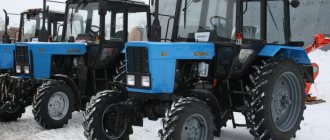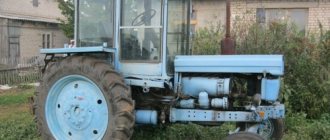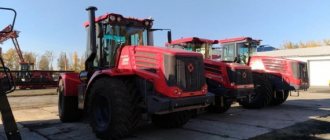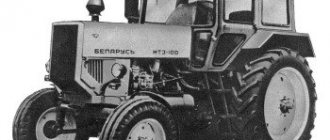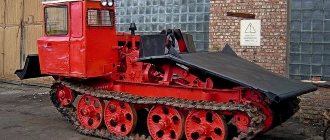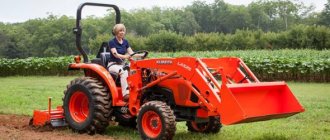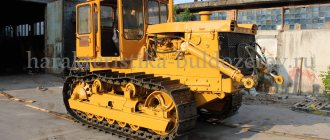T-40
The T-40 tractor on wheels is a unit produced at a plant in Lipetsk from 1961 to 1995. This model is currently out of production. The equipment could work with a mower, snow plow, stacker, and also processed crops that require plowing on light soils, in greenhouses, in gardens and plots. The universal design in the T-40 was equipped with various attachments. On farmland and farms, this unit was considered indispensable. Equipped with a trolley and a front loader, the "fortieth" was a unique agricultural machine. The tractor engine is classified as traction category 0.9. The power of its power plant reached fifty "horses".
The equipment of the T-40 mechanical transmission with reverse made it possible to use the entire set of forward and reverse speeds. Such a design, taking into account the possible design features of equipment for aggregation with attachments and trailers, manufactured for light type and heavy mechanization of the MTZ-82 type, objectively expanded the functionality of the "magpie" application.
What are tractors for? Give their classification.
A tractor is a self-propelled tracked/wheeled vehicle designed to move trailed and mounted vehicles and used as a base for building construction and road vehicles. Tractor transport is used in cases where it is not economically feasible to build roads or when, for technical reasons, the use of road transport is difficult / impossible (forest removal, development of a construction site, transportation of soil off-road).
Tractors are divided into agricultural, industrial and special (for mining, underwater, underground and other special work.)
According to the design of the undercarriage, caterpillar and wheeled tractors are distinguished. The main parameter of the tractor is the maximum traction force on the hook, according to the value of which they are assigned to different traction classes.
In construction, agricultural-type tractors of traction classes 1.4 are used; 2; 3; 4; 5; 6; 9; 15; 25 and industrial type thrust classes 10; 15; 25; 35; 50; 75.
Tractors of industrial type, in terms of their design and operational parameters, most correspond to the requirements for traction means and basic machines in construction.
The traction class means the maximum traction force without load of attachments in a gear of 2.5-3 km/h for tracked and 3-3.5 km/h for wheeled tractors, ensuring efficient work with earth-moving equipment.
The device and principle of operation of a caterpillar tractor. Give diagrams of mechanical transmissions of caterpillar tractors.
Any scheme of a caterpillar tractor displays the three main components of the tractor: engine, transmission and undercarriage. Engines are mainly used diesel, as the most economical. Transmission can be mechanical, electromechanical, hydromechanical. In the device of caterpillar tractors, an elastic and semi-rigid undercarriage is usually used. The elastic undercarriage allows the tractor to move more smoothly and faster. Semi-rigid undercarriage - transfers heavy loads and facilitates precise control of attachments when the tractor is moving.
In the tractor industry, two schemes for the device of a caterpillar tractor are used, with a front and rear engine. The classic layout scheme of a caterpillar tractor provides for the engine to be located in front. Such a scheme is convenient for agricultural tractors, because. provides a good view of trailed equipment and the engine balances the load from this equipment. The rear engine position and the front cab position are convenient for bulldozer operation, but the transmission design is complicated.
Depending on the suspension of the caterpillar tractor, the frame of the tractor can be frame, semi-frame or frameless. If the tractor has an elastic paired suspension of road wheels, then it has a frame frame. For a tractor with a frame frame, the main components and assemblies are mounted on a welded frame. This simplifies the repair work and facilitates the mechanisms of the tractor. The disadvantage of this design is that the frame is deformed during operation, and the connecting parts between the mechanisms wear out faster. Tractors with a semi-rigid suspension have a semi-frame frame. They occupy an intermediate position between frame and frameless tractors. Tractors with rigid or elastic group suspension of rollers to the balancer have a frameless frame. The disadvantage of such a frame is that it is difficult to mount attachments and equipment of the tractor itself on it. The advantage is rigidity, which makes it possible to do without couplings between the tractor units.
Rice. Fig. 11. Arrangement of mechanisms on the tractor: a - wheeled general purpose tractor; b - caterpillar tractor; c - self-propelled chassis; 7 - radiator; 2 - engine; 3 —clutch; 4 - gearbox; 5 - rear axle; 6 - central gear; 7 - differential (turning mechanism for caterpillar tractors); 5 - final drive; 9 - drive wheel (caterpillar); 10 - guide wheel
Tractor: MTZ review
More than a hundred models of tractors with various technical nuances are produced at the production facilities of MTZ OJSC. Including: walk-behind tractors, mini-tractors, small-sized units, as well as caterpillar devices.
Among all the variety, "Belarus" (tractor) stands out favorably. This is a unit that, according to its tech. characteristics are not inferior to foreign analogues, and due to the affordable price and high quality, it is a success not only in the former socialist countries, but also in European countries.
Tractors MTZ-82 ("Belarus") inspire pride in the domestic manufacturer, which influenced the well-deserved recognition and respect for this brand everywhere.
Choosing a tractor: features and characteristics that you need to keep in mind
We have already written how to choose the right mini-tractor, which is useful in a small farm or in a summer cottage where the power of large-sized equipment is not required. Today we will talk about a full-size tractor and how to choose the right one.
Compared with a mini tractor, a conventional tractor has its drawbacks. It is not advisable to use it in small areas, for example, in vineyards: it may be difficult to move, as well as to store this machine. Also, a full-sized tractor is much heavier than the miniature version and won't take as good care of your lawn, so if your goal is to preserve the landscape, then it makes sense to look at a mini-tractor. Another disadvantage is the price of the tractor. While a Russian mini-tractor can be found for 500 thousand or less, the price of a tractor starts at a million rubles. You can buy a new tractor or a used tractor on our trading platform, where you can also buy tractor attachments. You can also rent a tractor.
However, there are tasks that a mini-tractor may not be able to cope with due to the low engine power. These include the use of heavy attachments, as well as working with difficult soil (for example, frozen). In addition to these tasks, a full-size tractor is useful in construction, for cleaning the territory, transporting goods and various earthmoving operations. This machine will become an indispensable assistant in agriculture and public utilities, when it becomes necessary to process a large area.
What to look for when choosing a tractor?
Type of work performed
For snow removal, mowing lawns, plowing a small garden, you do not need the power of a large tractor, and an average one will cope with these works. For sowing, plowing large fields and harvesting, you will need a large tractor. The larger the cultivated area, the more powerful tractor will be required. However, for work in vineyards, for example, it is important to take into account the dimensions of the tractor so that it does not damage the plants when driving along the paths between them.
Attachment
If you need to transport weights or crops, you need to buy a trailer for the tractor. To clean the lawn or mow fodder cereal crops, you will need a mower, for harvesting - a rake, for transporting hay - a shovel, an irrigator for watering a field or garden, and a plow for plowing. For snow removal, you can purchase a blade or a rotary snow blower, if you plan to use the tractor as a front loader, then you need to purchase buckets.
terms of Use
If you plan to use a tractor in central Russia, which is characterized by rain, slush and mud, it is best to purchase a closed model with large wheels that will withstand bad weather. If the area where the work is carried out is hilly, bumpy or viscous, an all-wheel drive model is needed, in which all wheels can be driven, and not only the rear wheels, as in the rear-wheel drive. Such tractors are more powerful and will not get stuck if the road deteriorates due to bad weather.
Engine power
The engine power of the selected tractor determines how quickly it will move through difficult soil, and how much fuel it will cost. In addition, engine power directly affects the comfort of using attachments, for example, how big a plow is able to pull a tractor. If you have to dig poles, twist stumps, do grader work, loosen and cultivate the land, then you need a tractor with a power of at least 18.6 kW with the appropriate attachments. To deliver feed or work with large haystacks, a tractor of at least 37 kW is needed. However, the engines of most full-size tractors are much more powerful.
Tractor dimensions
The size of the tractor determines not only whether it will be able to work on the territory (whether it will pass between vineyards, whether it will hit cars, and so on), but also the ability to use heavier attachments, as well as the carrying capacity of the machine. The larger the tractor, the heavier it is, which means the heavier canopies it can use and the heavier loads it can carry. If you do not need to work with heavy sheds or loads, and there is a need to work in a limited space (for example, driving into a barn), a smaller model or mini-tractor is needed, or, as in the case of vineyards, a special model with a narrow wheelbase.
Which tractor to choose?
Once you've determined that you're looking for a full-sized tractor: whether you need to work in large areas, in capricious weather conditions with difficult soil, and with heavy attachments, or you need to transport heavy loads. You also have a rough idea of what dimensions your tractor should have, attachments, engine power, and so on. Now you can proceed to the direct selection of the model, so we have compiled a small selection of tractors that you can pay attention to.
Petersburg Tractor Plant
PTZ has 12 agricultural tractors in its arsenal. Their carrying capacity varies from 4 (K-424 Premium) to 9 tons (K7-M), engine power from 240 (K-424 Premium and Premium-1) to 428 hp. All presented tractors are equipped with a closed cab, which allows them to be used in bad weather. Kirovets K-424 is a universal farm tractor most effective for farms with arable land from 500 hectares to 2000 hectares. K7-M is useful for basic and pre-sowing tillage, effectively work with seeders and seeding complexes for sowing both tilled and non-tilled crops and is suitable for transport work, fertilization, ensiling, snow retention, road clearing. Both tractors are all wheel drive. For the K-424, you will have to pay about 5.7 million rubles, for the K7-M - about 7.5 million.
The plant has a telegram bot that you can ask questions about the operation of equipment with photos attached. You can buy equipment on lease, preferential loans with a low rate are available, which is important in a crisis.
Minsk Tractor Plant
There are 7 tractors in the arsenal of MTZ, the engine power of which varies from 212 (BELARUS-2103) to 359 (Belarus-3522 and 3525) hp, they lift 8-10 tons, respectively. There are also models with a caterpillar undercarriage (BELARUS-2103), which are suitable for general-purpose work on waterlogged soil. Model 3525 is designed to perform energy-intensive agricultural work in traction and traction-drive modes as part of wide-cut and combined units, including layered hitching, on the main and pre-sowing tillage, sowing grain and other crops, harvesting fodder, harvesting root crops, grain and industrial crops; for carrying out transport works, stationary works, in construction and industry. Model 2103 can be found at a price of 9.9 million rubles, 3525 - about 10.7 million rubles.
Like PTZ, MTZ offers leasing programs for a period of 12 to 60 months.
John Deere
In Russia, the manufacturer presents 3 series of high power tractors from 295 to 570 hp: 8R, 9R, 9RX in ascending order of power. The load capacity of the 8270R model is about 8.6 tons, the 9570RX is 9 tons. The 9570RX is ideal for towing the heaviest loads and makes cultivating, ploughing, loosening and planting much easier. Price for foreign tractors corresponding: 9570RX
can be found for 33 million, 8270R - about 10 million rubles.
Case IH
The American company offers two lines of enclosed cab tractors with engine power exceeding 200 hp: Steiger and Magnum. There are 8 models in the Steiger line, some of them move on four tracked chassis, which have an increased contact area with the surface for increased flotation. This makes it possible to take equipment to the field earlier than usual and to overcome wet areas with ease that conventional wheeled tractors and even tractors with two tracks cannot. Tractor engines have power from 446 to 670 hp. and can move loads weighing up to 17.4 tons, lift - up to 5. The most powerful tractors of the line can be found for 25 million rubles.
Tractors of the Magnum line (there are 5 in total) lift up to 10.5 tons, their engine power varies from 285 to 375 hp. For tractors of this line, you will have to pay up to 9 million rubles. A powerful lighting system is built into the tractors, which will allow you to work around the clock in comfortable conditions.
Suokone
The Finnish company offers a tractor on a caterpillar chassis - MeriTractor MT-700. Different types of caterpillars can be installed on the tractor, depending on the purpose and operating conditions. Steel tracks are suitable for hard surfaces where maximum mechanical strength is required. Rubberized caterpillars will help when you need a quick movement of the tractor: they provide a speed of up to 18 km/h (additional option - hydraulic suspension). In conditions where the pressure on the ground should be minimal, it is possible to use dual rubberized tracks. Installing and removing twin tracks is possible in the field. The tractor is offered in two versions with two different diesel engines: Volvo TAD 1643 VE (Tier 2) and Volvo TAD 1672 VE (Tier 4 Final). The latter is more environmentally friendly, but less powerful: 700 hp. against 768. The carrying capacity of both is 9 tons. The price of mulchers from the same company reaches 5 million rubles.
Outcome
You cannot do without a tractor if you need to process a large area (for example, in agriculture or municipal services), which a mini-tractor will not cope with or will be inefficient. It will also come in handy if you need to work with difficult soil (for example, frozen) or heavy sheds, as well as transport and lift heavy loads. These tractors usually come with a closed cab out of the box, which allows them to be used in winter or in bad weather without paying extra for it, as in the case of some mini tractors. When choosing a tractor, keep in mind the desired operating conditions of the tractor, dimensions (vineyards will require a more compact model), necessary attachments (snow blower, trailer, plow, etc.), engine power (some equipment may require a more powerful engine).
Technical properties of T-40
The tractor in question is a unit that has the following technical indicators:
- Weight 2,595 tons.
- Length / width / height (m) - 3.6 / 1.62 / 2.1.
- Speed range - 2.2-26.6 km / h.
- Slow transmission.
- Ground clearance (clearance) (cm) - 50.
- Adjusting track (m) - 1.2-1.8.
The tractor-excavator was equipped with four-stroke diesel engines D-37 and D-144, which were manufactured by a plant from the city of Vladimir. Power D-37 - 37 "horses", D-144 - 50 horsepower. The start of the power plant on some models was carried out by means of MPE (gasoline) or an electric starter.
Later, the D-37M power unit appeared, featuring an inseparable combustion chamber, which guarantees less fuel consumption. The tractor motor consisted of a fuel and air supply system, crank and connecting rod arrangement, a cooling kit, a distribution unit, a starting device and oil wiring.
Tractor device
Main article: Tractor device
Peace tractor, 1920s
The main elements of the tractor: engine, transmission, running gear, control mechanisms, working and auxiliary equipment. Regardless of the type, the power plant of modern tractors is a diesel engine (previously, gasoline, kerosene, gas generator, oil internal combustion engines were also used). The steering gear of wheeled tractors is similar to that of a car. To carry out the rotation of caterpillar tractors, one of the caterpillars is braked by a friction clutch.
Working equipment: Tractors are equipped with a hydraulic mounted system (HNS), which serves to connect the tractor with a mounted and semi-mounted machine, and control the operation of these machines. The HPS consists of two main parts: an attachment and a hydraulic system. Also, many tractors have a power take-off shaft (PTO), which is designed to drive working bodies aggregated[7] with tractors of mobile or stationary machines.
Equipment
On the left side of the engine there is a deflector, fuel filling, inlet and outlet pipelines. On the right side of the structure there is a starter, a generator, nozzles, a decompressor drive, an oil centrifuge and a generator. The working element of the fan and the generating unit, the hour meter, the hydraulic pump are located in the front plane of the machine. The fuel supply mode is adjusted by a throttle disc installed in front of a special protective mesh of the fan and oil cooler.
When the unit was operating in sub-zero temperatures, it was recommended to deactivate the radiator from the oil system and fix the throttle disc on the studs in front of the fan grid. In case of excessive heating or positive ambient temperature, reverse actions were taken. You can control the thermal regime using the indicators of the installed thermometer.
Operation features
Although a tractor and agricultural machinery, that is, a hardy machine, it nevertheless requires regular maintenance. When operating most domestic models, it is desirable to observe the following rules:
- Avoid excessive stress on a cold, freshly overhauled or new engine that has not been previously run in.
- Do not use a machine with low oil pressure.
- Avoid running for a long time when the motor is overloaded.
- It is not allowed to operate the engine without the casing of the ventilated device.
- It is dangerous to fill the power plant with unacceptable variations and types of oil.
- It is not recommended to leave the engine idling for a long period of time.
- Do not expose the machine to operation at a low oil temperature in the crankcase (less than 55 degrees).
- It is undesirable to operate the motor with a faulty air cleaner or without it.
Compliance with these simple recommendations and the conditions specified in the instruction manual will greatly extend the life of the vehicle without compromising quality indicators.
Characteristics of tractors of some series from MTZ
The 132H minitractor, taking into account its excellent technical features, compact dimensions and affordable price, is a good purchase. It is used in summer cottages, weeding and harrowing light soils, hilling land and other agricultural manipulations. The mini-tractor "Belarus" is applicable where a PTO drive is required, including when performing utility work.
The MTZ tractor and agricultural machinery, due to their distinctive performance, small dimensions and reasonable cost, are in the focus of attention of gardeners and specific communal communities.
The unit under the index 310 is excellently suited both for work on the backyard territory, and for weeding and hilling work and cultivating farmlands. In addition, this model is in demand in construction and utilities.
What is the difference between a tractor and an excavator?
Excavators, like tractors, are also included in the class of special-purpose vehicles. In terms of design, they are quite similar, but there are differences between them. The first of them is the presence of buckets of various sizes in the standard equipment of the excavator, while it is initially absent on the tractor.
Another important difference between a tractor and an excavator lies in their areas of application.
The excavator is used in the following industries:
- during the construction and demolition of obsolete buildings;
- in road construction;
- in quarries and mine workings.
The main feature of modern excavators is the presence of a wide choice of working elements used for operation. If necessary, instead of buckets, handles, arrows, as well as pile masts can be installed on the unit.
To work as an excavator, it can be equipped with the following types of buckets:
- standard excavator buckets - used for the destruction of buildings and clearing the territory;
- loading buckets - are actively used in workings of rocks for loading trucks with mined ore;
- clamshell buckets for two or more jaws - special load-gripping devices used to transfer bulky materials;
- bucket hooks - these structures are used to suspend and carry large products held by cables;
- buckets-rippers - are used in the development of minerals for the purpose of crushing the upper layers of rocks.
Depending on their size, excavators can be used to work in different enterprises. Large-sized machines are successfully operated on open bases, while small-sized excavators have found their application in closed warehouses.
Interesting Facts
A tractor is not only an agrarian worker, but also a candidate for participation in the motor transport competition in terms of power, dimensions and other indicators. Below is an overview of the largest unit in the world.
The giant tractor is called Big Bud 16V-74.” In translation, it sounds like "a huge larva." Multi-valued digital designations complement the characteristic for a reason. They testify that it is difficult for this tractor on the ground to find equal competitors in size. Many manufacturers tried to create such giants, but no one could achieve such indicators, coupled with aggressive force.
This tractor is a unit produced in a single copy. It was developed by the American billionaire Harmon.
Its dimensions, equipment and power are impressive, but there is little practical use from it, even though the colossus is capable of dragging a plow thirty meters wide with a plowing depth of up to three hundred centimeters. The main problem in the further development of this monster was the difficulty of its transportation.
Rating of the giant tractors of the world
Among the "giants" it is necessary to highlight the following models:
- Of particular note is the tractor, an overview of which is presented below. This is TERRION ATM 7360 (Petersburg Tractor Plant). Its power indicators are 360 "horses".
- Fendt Vario 936. This giant farm tractor has a power unit of up to five hundred horsepower (depending on engine modification). The German company AGCO Corporation produces a masterpiece of mechanization.
- Massey Ferguson 8690. Another tractor-style monster produced in the British Isles. Its power is equal to 370 "horses".
- The next model is the pride of Germany. This is a colossus called Claas Xerion 4500. Its strength is 483 horse units.
- 535 "horses" are placed in the New Holland T9000, produced in the Netherlands. It is equipped with a 15 liter engine.
- In the list of leaders in the production of agricultural machinery is John Deere Corporation. Its unique powerful units are John Deere 8345R / 8360R with 360 horsepower and 9R series tractors with 560 horsepower. The equipment of this manufacturer serves more than half of the world's fields and plantations.
- One of the outstanding agricultural assistants in every sense is the Soviet all-terrain vehicle on T-800 tracks. This is a tractor-excavator, which is listed in the Guinness Book of Records. Its length is 12.4 m, which is three times that of Big Bud. The height of the manipulator is almost 5 m, which is 50 centimeters less than the American counterpart . But in terms of mass, the colossus surpassed everyone (160 tons). The unit is equipped with a BelAZ gas turbine power plant.
Tractors for agricultural work
Tractors intended for agricultural work have some features associated with their operation (for example, the need to process large areas, the operation of machines in various weather conditions). That is why agricultural tractors must meet a number of important requirements:
- Possibility of carrying out repair work in the field.
- Possibilities for quick replacement of mounted or trailed devices.
- Opportunities for uninterrupted operation in conjunction with some units both at high and low speeds.
- The versatility of devices that connect the tractor and attachments.
For maximum compliance with all the requirements, agricultural tractors are equipped with engines with an increased number of revolutions, multi-stage gearboxes, sprung suspensions, universal hinged systems (for example, pendulum, lever or lever-pendulum), creepers.
Tractor equipment for agricultural work, which was produced in the Soviet Union, was divided into classes depending on the traction force on the hook. For example, the Rioni tractor - 0.2, the T-25 tractor - 0.6, T-40 - 0.9, MTZ-50 and 80 - 1.4, the T-54C tractor - 2.0, DT-75 - 3.0, T-4A - 4.0, K -700 - 5.0, T-130 - 6.0.
Tractors for agricultural work are divided into two types - general purpose and tilled.
History of creation
Tractors and agricultural machinery based on them appeared thanks to the invention in 1850 by the Englishman William Howard of the first such unit. The device was a steam structure designed for plowing the land. The idea developed so much that such plows were widely used in Europe already in the 19th century.
The initial samples had a large mass, which negatively affected the quality of soil treatment. Repairing them was costly and time consuming. After some time, modernized models of tractors appeared, which became lighter and more reliable. After the start of mass production in the USA alone in 1920, more than two hundred thousand units of such equipment were sold.
Tracked examples appeared in the United States (1912). Soon the tractor became an indispensable assistant on the agricultural plane. He was entrusted with the bulk of the harvesting work. In the Russian expanses, the first unit with a steam engine was assembled by a descendant of peasants - Blinov Fedor from the Saratov district.

